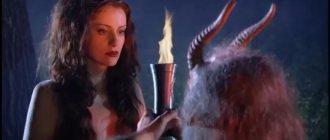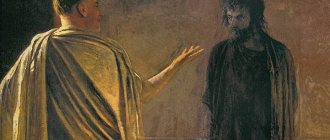The idea of the creation of the work
Now it is no longer known exactly when the idea of the work and its images were born. It is known that the writer was very fond of Goethe’s Faust; in one of the first versions of the novel, he called the master Faust. Perhaps it was the brilliant work of the German poet that gave the first germs of ideas for Bulgakov’s no less brilliant novel.
In the history of writing “The Master and Margarita” there are many “blank spots”. There is evidence that brief rough notes were made by Mikhail Bulgakov back in 1928-1929. But in the first novel, all 160 pages of the manuscript were devoted to the story of Christ and the procurator and Woland’s sparkling stay in Moscow with his unusual tours and revelations of the greedy public. There was no place here for the master and Margarita, although it was thanks to them that the novel became so diverse and humane.
Among the options for the title of the work were “The Engineer’s Hoof” and “Woland’s Tour”, “The Prince of Darkness” and “The Black Magician”, but shortly before his death, in 1937, Bulgakov called his immortal work “The Master and Margarita”. Editing the written chapters of the novel will last as long as the writer’s heart beats. Then the work will be continued by his wife. During the writer's lifetime, his greatest work will neither be completed nor published.
Key to the book's title
Despite the fact that the introduction of a female character into the novel about the devil and the poet belonged to the writer’s second wife Lyubov Belozerskaya, the true “Margarita” for the writer himself will be his third wife, Elena Sergeevna. Like the heroine of the book, the woman will leave her husband for the sake of the writer and completely devote herself to her lover and his craft, faithfully staying by his side and helping until the end of his and then her days. The inspiring power of female love that Bulgakov found in the person of his last life partner finally convinced the author of the need to include the image of Margarita in the plot.
Speaking about the prototypes of the main characters, the legendary “Faust” comes to mind. In addition to the epigraph about the devil, Mikhail Afanasyevich also drew from Goethe and Margarita (Gretchen) from the German mystical classics. Researchers also name the French princess Margarita of Navarre as a prototype of the Master’s muse. Nevertheless, the wife of the creator of the novel about Pilate and the real beloved of the classic of Russian literature still have the most similarities and features in common. Even such a little thing as Elena’s slight squint was transferred into the image of the heroine after she used Azazello cream.
Thus, of the ideas the writer had regarding the naming of his opus, the final one turned out to be the most successful, sonorous and meaningful in terms of meaning. Interpreting the title of Bulgakov’s work, one can find obvious similarities between the author and his hero, namely:
- committing the manuscript to fire;
- harsh criticism of creativity;
- wife's devotion and help.
The title "The Master and Margarita" was chosen by Bulgakov as the final title in 1937 after introducing a loving young woman into the storyline. The love parts of the work are one of the key ones , so the title accurately reflects the content of the book. And although there is not even a hint of the devil in the final version of the name of the novel, from the point of view of Bulgakov scholars, two symmetrical capital letters “M” carry the encrypted symbolism of the words “Moscow” and “Woland”, which implies a reference to the image of the Prince of Darkness with his retinue , and to the Moscow chapters of the book.
"Manuscripts don't burn"
The spring of 1930 was a turning point for the writer and his work. In a fit of dissatisfaction with his work and under public pressure, Bulgakov burned the first version of the novel. Later, in the already written work, the desperate master will also burn his manuscript: “I took the heavy lists of the novel and rough notebooks out of the desk drawer and began to burn them.” The master will be stopped by the arrival of Margarita, and the manuscript of the novel will later be brought back to life by Woland, uttering the phrase that has become an aphorism - “Manuscripts do not burn”!
Two years later, having found the surviving parts, Mikhail Bulgakov will begin to create his novel again. In his letters to a friend, he will write that “he himself does not know why he is doing this.”
In 1940, the writer was severely debilitated by illness. Not having the strength to get up, he dictated amendments to the novel to his wife, who, like Margarita, was completely absorbed in working on her husband’s latest work.
After the death of the writer, his widow Elena Sergeevna will edit the novel for about two decades and make attempts to publish it. The story of the master and Margarita will become for her the last will of her husband, and the meaning of her life.
History of creation
The story of the creation of the novel is full of difficult moments, secrets and experiences. The work is rightfully considered the crown of the author, to whom all creative forces and fantasies were given.
Work on The Master and Margarita began in 1928. It is not known for certain when and how exactly the idea of creation came about. However, according to some sources, it is believed that Bulgakov allegedly drew inspiration from “Faust” - an equally famous text by J. V. von Goethe.
("Le Faust" Goethe, edition 1847)
The very first sketches of the novel were made during Bulgakov's stay in Moscow. Initially, the work had several options for plot development. One of them was entirely devoted to the story of Pilate, the other did not include stories about the Master and Margarita, about Woland’s arrival in Moscow and about the peculiarities of the events unfolding on Patriarch’s Ponds and on Sadovaya Street,
Another interesting fact is that the writer’s last wife, Elena Sergeevna Shilovskaya, is considered the prototype of Margarita. Some connoisseurs of the novel are also inclined to consider her a co-author of the work, since when reading it, two completely different styles of writing are felt.
(Mikhail Bulgakov's wife Elena)
The novel also did not get its name right away. The author proposed several options: “Prince of Darkness”, “Woland’s Tour”, “Juggler with a Hoof”, and also “Black Magician”. Later Bulgakov settled on The Master and Margarita. This happened some time before the writer’s death. His wife continued working on the famous novel. This fact is known and proven.
Needless to say how important this work was for Bulgakov. He gave her all of himself and for many years diligently came up with the plot of the now world-famous novel. As proof of this, the author’s remark written on one of the drafts is: “Help, Lord, write a novel.”
The novel “The Master and Margarita” became Bulgakov’s posthumous brainchild. Unfortunately, during his lifetime it was not published and did not even have its ending. However, the deep thought, interesting plot and unusual style of narration made the work famous throughout the world.
The fate of the novel
Having invested a lot of effort into editing the novel, Elena Sergeevna could not find a place for it in publishing houses. She was refused, sent to other offices and to higher authorities, “for fear of making a decision about printing alone.”
One publishing house answered her with the laconic phrase “Not the time.” Indeed, the novel was very progressive for its prim and too traditional time. Only almost three decades after Bulgakov’s death, the novel will be accepted for publication and published by the Moscow magazine. This will happen in 1967-1968, but the version will be edited and greatly shortened. Many of Woland’s monologues, as well as the description of the devil’s ball and Margarita, will be cut out.
For the first time, the original version of the novel without censorship restrictions will be published by the Posev publishing house. This will happen in 1969 in Germany, and the Soviet Union learns about the fate of the master and Margarita in 1973, thanks to the authorities’ permission to publish previously prohibited works.
Stages of work
(The Master and Margarita was written behind such a cabinet-table. Bad apartment No. 50. Bulgakov Museum in Moscow. Photo: Vadim Indeikin, 2016)
Work on the novel began in 1928. Bulgakov carefully thought out the plot, looked for inspiration and made sketches. Over the course of 2 years, the author wrote about 160 pages (according to currently known data).
In the spring of 1930, the writer tries to burn his manuscript. This moment was difficult for him, as he was under the influence of the public and was experiencing some kind of crisis. Later he greatly regretted what he had done, but some parts of what he wrote could not be saved.
Two years later, Bulgakov resumes work on the novel based on the surviving manuscripts. In surviving correspondence with his friend, the author says that he has no idea what he wants to do and what, in the end, he will succeed.
In 1940, the writer fell ill. He doesn't have enough strength to continue working. Therefore, he dictates to his wife the necessary corrections and additions. Elena writes everything down carefully and is deeply immersed in her work.
March 10, 1940 Bulgakov dies. Work on the novel stops.
(Mikhail Bulgakov with his wife Elena)
After some time, Elena takes up the work of her late husband and for many years carefully edits and rereads the text. According to some known data, work on the work continued for about 20 years after the author’s death and until the novel was published.
Problems
The novel raises many problems: philosophical, social and even political.
The main problem is cowardice
. The author called it the main vice. Pilate did not have the courage to stand up for the innocent, the Master did not have the courage to fight for his convictions, and only Margarita plucked up the courage and rescued her beloved man from trouble. The presence of cowardice, according to Bulgakov, changed the course of world history. It also doomed the inhabitants of the USSR to vegetate under the yoke of tyranny. Many did not like living in anticipation of the black funnel, but fear defeated common sense, and the people resigned themselves. In a word, this quality interferes with living, loving and creating.
The issue of love is also important
: its influence on a person and the essence of this feeling. Bulgakov showed that love is not a fairy tale in which everything is fine, it is a constant struggle, a willingness to do anything for the sake of a loved one. After meeting, the Master and Margarita turned their lives upside down. Margarita had to give up wealth, stability and comfort for the sake of the Master, make a deal with the devil in order to save him, and not once did she doubt her actions. For overcoming difficult trials on the way to each other, the heroes are rewarded with eternal peace.
The problem of faith
also interweaves the entire novel, it lies in Woland’s message: “Everyone will be rewarded according to his faith.” The author makes the reader think about what he believes in and why? This gives rise to the all-encompassing problem of good and evil. It was most clearly reflected in the described appearance of Muscovites, so greedy, greedy and mercantile, who receive retribution for their vices from Satan himself.
Two worlds of Bulgakov
The worlds of Yeshua and the Master are more closely connected than it seems at first glance. Both layers of the narrative touch on the same issues: freedom and responsibility, conscience and fidelity to one’s beliefs, understanding of good and evil. It’s not for nothing that there are so many heroes of doubles, parallels and antitheses here.
The Master and Margarita violates the urgent canon of the novel. This story is not about the fate of individuals or their groups, it is about all of humanity, its fate. Therefore, the author connects two eras that are as distant as possible from each other. People in the times of Yeshua and Pilate are not very different from the people of Moscow, the Master’s contemporaries. They are also concerned about personal problems, power and money. Master in Moscow, Yeshua in Judea. Both bring the truth to the masses, and both suffer for it; the first is persecuted by critics, crushed by society and doomed to end his life in a psychiatric hospital, the second is subjected to a more terrible punishment - a demonstrative execution.
The chapters dedicated to Pilate differ sharply from the Moscow chapters. The style of the inserted text is distinguished by its evenness and monotony, and only in the chapter of execution does it turn into a sublime tragedy. The description of Moscow is full of grotesque, phantasmagoric scenes, satire and ridicule of its inhabitants, lyrical moments dedicated to the Master and Margarita, which, of course, determines the presence of various storytelling styles. The vocabulary also varies: it can be low and primitive, filled even with swearing and jargon, or it can be sublime and poetic, filled with colorful metaphors.
Although both narratives are significantly different from each other, when reading the novel there is a feeling of integrity, so strong is the thread connecting the past with the present in Bulgakov.









